Safe Streets and Roads for All (SS4A) Overview
The Safe Streets and Roads for All (SS4A) discretionary program was established by the Bipartisan Infrastructure Law with $5B in appropriated funds over five years. The program, administered by USDOT, funds regional, local, and Tribal initiatives through grants to prevent roadway deaths and serious injuries.
The program has awarded federal grants to more than 1,000 communities in all 50 states and Puerto Rico for planning, demonstration, and implementation activities.
Applications for the next round of SS4A grants are anticipated to open in February 2024.
The Local Infrastructure Hub is highlighting Tampa’s implementation of their Vision Zero Action Plan, with funding from the Safe Streets and Roads for All grant program, to illustrate how cities across the country can use program funding. The City of Tampa, Hillsborough County, and their Metropolitan Planning Organization, Plan Hillsborough, have all received grant awards through this program to support the realization of their Vision Zero Action Plan and associated safety interventions.
Considerations for municipal leaders
- What are the systemic risk factors for traffic safety in the community?
- What groups are overrepresented in traffic safety data and why?
- What specific roadways, intersections, and geographic areas are overrepresented in traffic safety data and why?
- Who is responsible for roadway design and maintenance on your most impacted roadways?
- How do “Vision Zero” and other safety initiatives fit into local and regional transportation priorities?
- How can roadway design be aligned with land-use planning and zoning to ensure safety for all users and mode types?
The Safe Streets For All Project
Project Leadership:
- Mayor Jane Castor
- Alex Henry, Chief Planner, City of Tampa Mobility Department
Location: City of Tampa
Focus: Public Safety, Racial Equity
Key Project Dates/Timeline:
Having completed their Vision Zero Action Plan in December 2021, Tampa is using the SS4A grants, alongside other federal grants, including Reconnecting Communities Pilot and BUILD grants, to implement the recommendations of the plan. Tampa will be able to implement safety interventions at sites throughout the city with speed, by using their Quick Build Program of projects and working fully within the right of way, making it easier to get requisite approvals for construction. The timeline for the Quick Build Program of projects relies upon the disbursement of grant awards, as well as the city’s staff capacity. However, all 17 Quick Build projects identified in the grant application are expected to be completed by the end of FY 2027 with more complex projects and evaluation activities continuing into FY 2028, the final year of the grant award.
Overview
Mayor Jane Castor campaigned on a vision for safer streets in Tampa, historically one of the most dangerous metros in the country for drivers and pedestrians. After taking office, Mayor Castor signed the Vision Zero pledge, committing to a strategy to eliminate all traffic fatalities and severe injuries, while increasing safe, healthy, and equitable mobility for all. The Safe Streets and Roads for All (SS4A) grants to the City of Tampa and regional partners are supporting the research, development, and construction of interventions to realize the city’s Vision Zero Action Plan.
Using these grants, Tampa is expanding their Quick Build Program that allows them to rapidly deploy low-cost countermeasures in high-priority corridors and underserved communities to protect vulnerable road users. Low-cost countermeasures within the program include but are not limited to new roadway markings to create separated bike lanes and extending curbs to shorten pedestrian crosswalks. Many traffic safety measures may take months or years to plan and construct, but through their innovative Quick Build Program, Tampa is able to substantially reduce the time needed for these implementations.
Tampa’s partners for this project include Hillsborough County, Plan Hillsborough (Hillsborough County’s Transportation Planning Organization/MPO), Hillsborough Area Regional Transit, Florida Department of Transportation (FDOT), and University of South Florida Center for Urban Transportation Research (USF-CUTR). The collaborative effort, funded largely by the SS4A awards, is part of the largest investment ever in roadway safety in Tampa, and the Quick Build Program enables the city to see its benefits quickly. Evidence of the program’s impact can already be seen in the declining trend of pedestrian and bicyclist fatalities in Tampa.
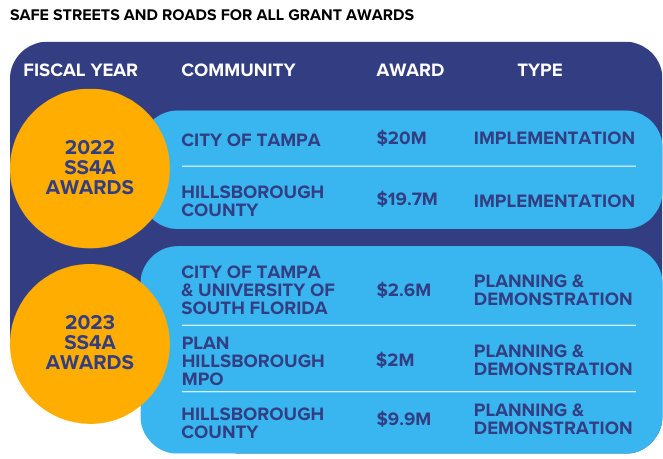
Project Challenges
Traffic Safety Challenges
According to Smart Growth America’s 2022 Dangerous by Design Report, the Tampa-St. Petersburg-Clearwater, FL metro area was the 4th most dangerous metropolitan area in the United States for pedestrians with an average 3.55 pedestrian deaths per 100,000 people per year. The Tampa Bay Times Editorial Board simplified the problem to roads being too dangerous to cross; in their words, the roads “are designed to move cars as quickly as possible, and pedestrians – literally – get in the way.” According to the Florida Traffic Safety Dashboard, in 2022 alone there were 77 traffic fatalities and 355 life-altering injuries on streets within the City of Tampa, and, in 2023 there were 53 traffic fatalities and 273 life-altering injuries (data for 2023 is only available through November 5, 2023). For comparison, San Francisco sees, on average, 30 traffic fatalities per year, despite having double the population of Tampa.
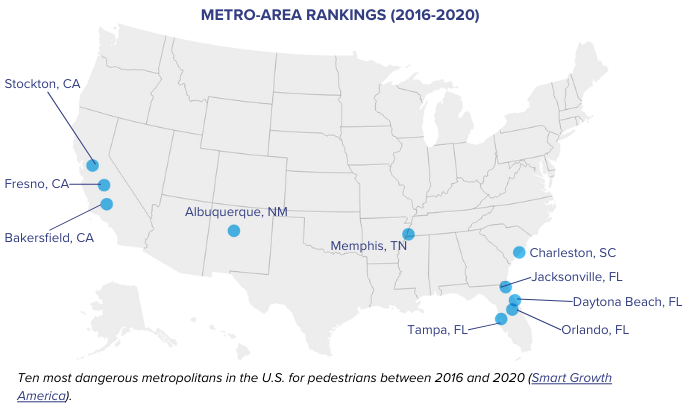
Prioritizing Transportation Infrastructure
In an interview previewing her first term as mayor, Mayor Jane Castor emphasized her priorities around investing in “great transportation… that connects all of [Tampa’s] neighborhoods,” to continue Tampa’s development. Shortly after taking office, in May 2019, Mayor Castor created the Transforming Tampa’s Tomorrow (T3) vision plan to take on the top priorities for Tampa’s future, including infrastructure and mobility. A key component within the infrastructure and mobility priority was for Tampa to join the Vision Zero Network, a network of cities and other government units committed to Vision Zero and prioritizing transportation safety. In 2020, the city was officially admitted as a member, creating access for the city to a network of leading cities and experts in transportation safety.
What Is Vision Zero?
Vision Zero is a systems-driven strategy to eliminate all traffic fatalities and severe injuries, while increasing safe, healthy, equitable mobility for all. Originating in Europe, the innovative strategy has been adopted across the globe. As of August 2022, 53 communities across the U.S. are part of the Vision Zero Network, an organization working to advance the Vision Zero strategy in the country.
Vision Zero departs from traditional transportation safety approaches by recognizing that people will make mistakes, and thus prescribing a multidisciplinary approach to design road systems that ensure that inevitable mistakes do not result in severe injuries or fatalities. As described by the Vision Zero Network, “Vision Zero is not a slogan, not a tagline, not even just a program. It is a fundamentally different way to approach traffic safety.”
(From https://visionzeronetwork.org/about/what-is-vision-zero/)
Tampa’s Vision Zero Action Plan
Hillsborough County, also a member of the Vision Zero Network, published a broad Vision Zero Action Plan in 2017. Mayor Castor’s administration saw the importance of focusing further and creating a plan specific to the city. Thus, in 2021 the city formed a Vision Zero Task Force to lead the development of the city’s Vision Zero Action Plan.
The Vision Zero Task Force, led by Mayor Castor, had three committees to focus on specific areas of concerns: 1) crash and countermeasures, 2) equity and engagement, and 3) city policy and programs. Tampa’s Vision Zero Action Plan was published in December 2021 and outlines steps the city will take over a five year period to embed Vision Zero practices across all city departments and throughout the community. Initiatives identified in the plan include increasing transportation options, aligning road design with land use policies, expanding and enhancing public transit, and sustainability.
In conjunction with the development of the broader Tampa MOVES plan development (outlined below), the Tampa Mobility Department hosted a series of 10 virtual meetings with Tampa’s neighborhoods to facilitate conversations with residents and hear their transportation-related desires and concerns. These meetings were supported with an online, public survey, reaching a broad audience of residents, including safety advocates as well as many respondents who had previously never heard of Vision Zero.
Through the work in developing the Vision Zero Action Plan, Tampa identified four core elements to a successful traffic safety program: 1) multidisciplinary leadership and commitment, 2) safer roads and safer speeds, 3) equity-based education and engagement, and 4) a data-driven approach for transparency and accountability.

A key component of all Vision Zero plans is the identification of the High Injury Network (HIN), which highlights concentrations of traffic deaths and serious injuries. According to Alex Henry, Chief Planner in Tampa’s Mobility Department, the Vision Zero Action Plan focuses on looking at the types of crashes that are overrepresented, as well as the geographic concentrations of deaths and serious injuries. As laid out in Tampa’s Vision Zero Action Plan, identifying the HIN enables planners to:
- Identify the most dangerous roadways belonging to all traffic jurisdictions within city limits,
- Identify characteristics contributing to injuries and deaths among all modes,
- Inform the prioritization, design, and funding of projects, and
- Strengthen the city’s efforts to advocate for safety improvements on roads managed and operated by other jurisdictions, such as county and state managed roads.
In Tampa, the 83.8-mile HIN represents 24% of road miles within city limits, but accounts for 73% of fatalities. A challenge for the city, however, is that the majority of the HIN corridors are state- or county-owned roads. Thus, it is important for the city to communicate and collaborate with those government entities to achieve shared safety goals. The city has leveraged their involvement with the local MPO, Plan Hillsborough, to facilitate enhanced coordination through the organization’s normal processes. Henry and his team have also been able to coordinate at the state level, via FDOT’s District Office, to better prioritize local needs in future state road maintenance and operations.
The Vision Zero Action Plan also identifies the most vulnerable road users in Tampa. While people on foot represent only 3% of the mode share, they represent 39% of fatal crashes and 16% of the life-altering injury crashes. Furthermore, for the 2014-2018 period, the city found that the groups most likely to be involved in fatal crashes were pedestrians between the ages of 56 and 75, cyclists under the age of 25, and new drivers aged 16 to 25. Three significant contributors to fatal and severe injury crashes were identified: speeding and aggressive driving, intoxication, and distracted driving.
The city sought to fully understand the local contexts and impacts of safety issues on their roadways, both on and off the HIN, and so equity considerations were a key component as the city developed the action plan. A primary way that they considered equity throughout the city was through mapping exercises to overlay “Communities of Concern” with the traffic safety data (see page 8). Communities of Concern were defined by Plan Hillsborough (the MPO) as census blocks meeting the criteria for concern set by the MPO. This involved an analysis of demographic data points, such as minority population, low-income households, individuals aged 65 or older, limited English proficiency, people with disabilities, zero-car households, and youth.
The Vision Zero Action Plan is not just a five-year plan for addressing roadway safety in Tampa; it is, in their words, a ‘living document’ that is set to be reviewed and updated on a regular basis. As such, there is not a set cost estimate for implementing the plan, but rather it is indicative of their long-term, community-centered approach to transportation safety in the city.
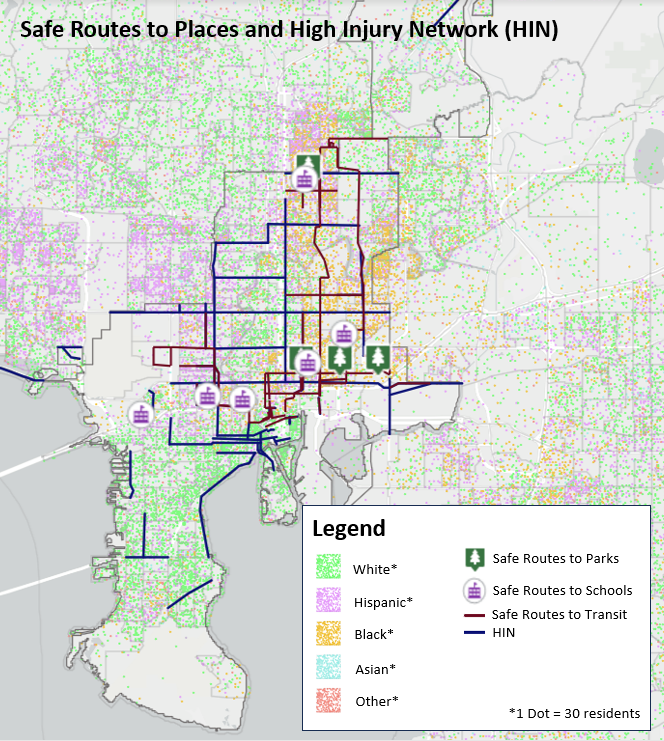
This map, produced by the Nowak Metro Finance Lab, uses data from the US Census Bureau 2022 5-Year American Community Survey, Table B03002 to determine density by race and ethnicity by census block group. Data on HIN and Safe Routes to Places was provided by the City of Tampa.
“Everyone using our roadways has the right to safe mobility so that they arrive to their destinations alive and unharmed. The City understands our responsibility to provide a safe street system for everyone. Even one deadly crash is one too many.” -Mayor Jane Castor
Tampa MOVES
Tampa MOVES (Mobility for All, Opportunity, Vision, Equity, and Safety) is their first Citywide Mobility Plan, focusing on plans and priorities for transportation needs over a thirty-year period. The plan, a pillar of Mayor Castor’s Transforming Tampa’s Tomorrow (T3) initiative, was released in July 2023 and provides the city with an equitable, data-driven approach to make Tampa’s transportation system better and safer than ever before, helping to prioritize $2B worth of mobility needs.
Like the Vision Zero Action Plan, the MOVES plan recognizes traffic safety and overrepresentation of vulnerable road users in traffic crash data as key areas of concern and identifies actionable strategies for addressing transportation safety. While the MOVES plan covers all aspects of Tampa’s transportation network, going beyond roadways, the city was able to use the long-term plan to further detail their Vision Zero aspirations over a 30-year period, enabling planners to ensure that the safety priorities are embedded in all transportation design, planning, and funding decisions.
Tamps’s Grant Awards
The City of Tampa has received two Safe Streets and Roads for All grant awards to fund the implementation of the Vision Zero Action Plan and invest in actions and strategies for safer roadways. They received a $20M award in February 2023, followed by $2.6M in a November 2023 award, in addition to a $5M and a $650K local match, for each respectively. Tampa’s February 2023 award provides funding for the Tampa Systemic Applications for Equity (TSAFE) project, which accelerates implementation of their Vision Zero Action Plan. The project’s approach is two-fold:
- Triage: $15.7M to address the immediate problem areas and roads with similar characteristics by using quick, low-cost treatments (Quick Build projects) to address the HIN and systemic crash risk factors (see the next section for more details on the Quick Build Program), and
- Preventive care: $7.3M to encourage mode shift by making walking, biking, and transit easy, comfortable, and safe options.
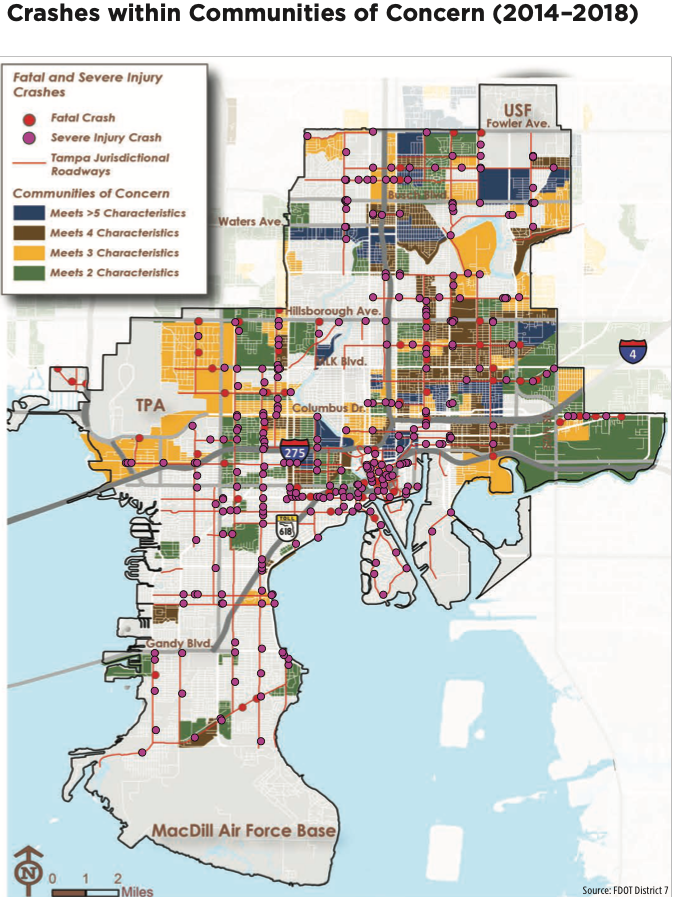
More detail on the Triage and Preventative Care projects can be found later in this study. The T-SAFE award also includes $2M for a supplemental effort to develop a Comprehensive Pedestrian Safety & Equity Action Plan that will further inform investments around pedestrian safety in the future. A significant majority of the overall funds (74%) will be focused on implementing projects and strategies to improve safety for people living in underserved communities.
The smaller November 2023 grant award, “SPEED: Systems Planning, Engineering and Evaluation Demonstrations,” focuses on speed management interventions in and around the city’s HIN. The city intentionally aligned the grant application with the MOVES plan, using Justice 40 principles to determine where to focus demonstration projects to maximize equitable impacts and analyzing differences between target speeds and measured speeds to identify where speed was a systemic risk factor. The City of Tampa will continue to work with University of South Florida’s Center for Urban Transportation Research (USF-CUTR), as a partner on the grant award. USF-CUTR supports the city’s investments in data-driven interventions and community-centered educational campaigns. With grant support, the research center will utilize data gathered around funded interventions to develop a Speed Management Evaluation Report that will serve as an addendum to the Vision Zero Action Plan and inform future investments in transportation safety.
Both grant applications and their requisite executions place an emphasis on equity. Demonstration activities in Tampa funded by these grant awards focus on corridors within areas identified as disadvantaged by the Equitable Transportation Community Explorer Tool and requisite components of Tampa’s identified HIN. In an interview, city staff explained the large difference between the February and November awards as being due to staff capacity limitations related to other federal grant awards for transportation projects in the city. The city also believed that after receiving a large award in the first round announced in February, they could be more competitive by applying for a smaller, targeted award for demonstration projects.
In addition to the City of Tampa’s two awards, Plan Hillsborough and Hillsborough County, have also received implementation and demonstration grants under the SS4A program. These include:
- $19.7M implementation grant to the county for data-driven transportation safety programs for interventions at high-priority locations for safe routes to schools, bus stop pedestrian safety and access, pedestrian corridor safety improvements, and Vision Zero corridor safety improvements;
- $9.8M planning and demonstration grant to the county for equitable transportation programs that will support demonstration and testing of safety approaches in priority areas including safe routes to schools, transit stop safety and access, pedestrian corridor safety, and bicycle safety; and,
- $2M planning and demonstration grant to the MPO to conduct safety analysis of speeds on the HIN corridors and identify priority corridors to pilot demonstration activities such as signal retiming and signage.
In sum, more than $45M in SS4A grant awards are going to the Tampa area to realize local and regional Vision Zero strategies and goals.
While the three grant recipients applied for and are executing their grant awards separately, the Vision Zero strategy and associated planning efforts have informed all five grant applications. The three grant recipients (city, county, and MPO) continue to collaborate, formally and informally, as they implement their grant awards to maximize the benefits for the region and create a safer transportation network for the Tampa metropolitan area.
Alex Henry, Chief Planner in Tampa’s Mobility Department, referred to the collective of the county, MPO, and city teams as a “small knit community of collaborators.” The teams from the city and county meet in various capacities formally at a quarterly, bimonthly, and biweekly basis focused on high-level planning efforts, project coordination, and safety topics. Together, they are dedicated to prioritizing safer transportation in the Tampa region.
Triage and Preventative Care Projects
Triage: Tampa’s Quick Build Projects
Tampa is using their SS4A awards to implement a Quick-Build Program of projects that targets deployment of safety treatments to the highest priority places (this is the “triage” component). The Quick Build Program uses materials like paint, signs, pavement markings, and other temporary materials to implement projects in a shorter time and at a lower cost than traditional methods. The design for the projects draw on new, nationally recognized standards for safe street design. These Quick Build projects focus on providing safety enhancements for all users. This is an important approach as it allows the city to rapidly deploy strategies and interventions to improve road safety to achieve important short-term safety goals, while identifying and developing reliable long-term solutions to address systemic risk factors.
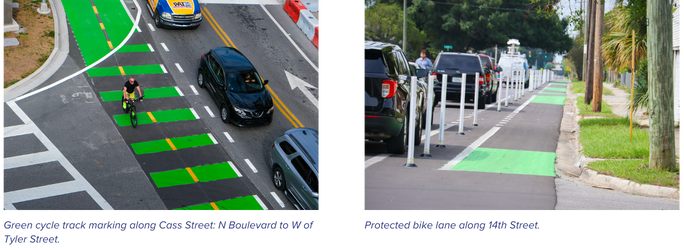
Tampa splits triage projects into two phases. The first phase includes Quick Build treatments across all of the city-owned HIN corridors in underserved communities, which they identify in their grant application. The second phase entails a second pass at the aforementioned HIN corridors to add additional countermeasures that require slightly more time and effort to implement, such as engineering design and further stakeholder engagement. The first phase is expected to be ongoing through the third year of the grant award, while the second phase will begin concurrently in the second year with expected completion by the fourth year of the grant (as noted earlier, the timeline is reliant on the disbursement of the SS4A awards).
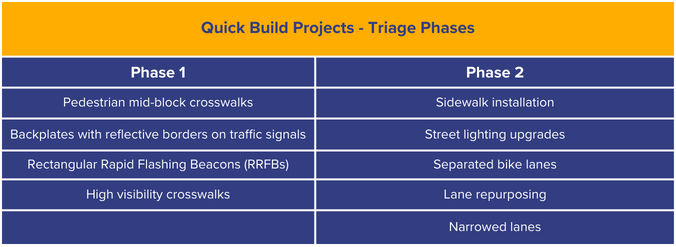
Preventative Care Projects: Safe Routes To Places and Comprehensive Pedestrian Action Plan
Preventive Care projects include a package of Safe Routes to Places projects to provide safe access to six schools, four parks, and along four transit routes. These routes and corridors were identified from studies conducted in partnership with Plan Hillsborough and Hillsborough Area Regional Transit. The projects along these routes will be coordinated with Plan Hillsborough, Hillsborough Area Regional Transit, Hillsborough County School District, and other relevant agencies for implementing the countermeasures. The proven safety countermeasures for Safe Routes to Places include:
- Enhancements to signage and pavement markings
- Sidewalk installation
- Street lighting upgrades
- Separated bicycle lanes
- School speed zone flashers
- Traffic calming High visibility crosswalks
This component also includes the development of a “comprehensive pedestrian safety & equity action plan.” The plan will be data-driven with inclusive stakeholder and public engagement as the plan supports the development of actionable strategies to create a replicable structure and toolkit to implement pedestrian safety strategies citywide and deploy further Quick Build interventions.
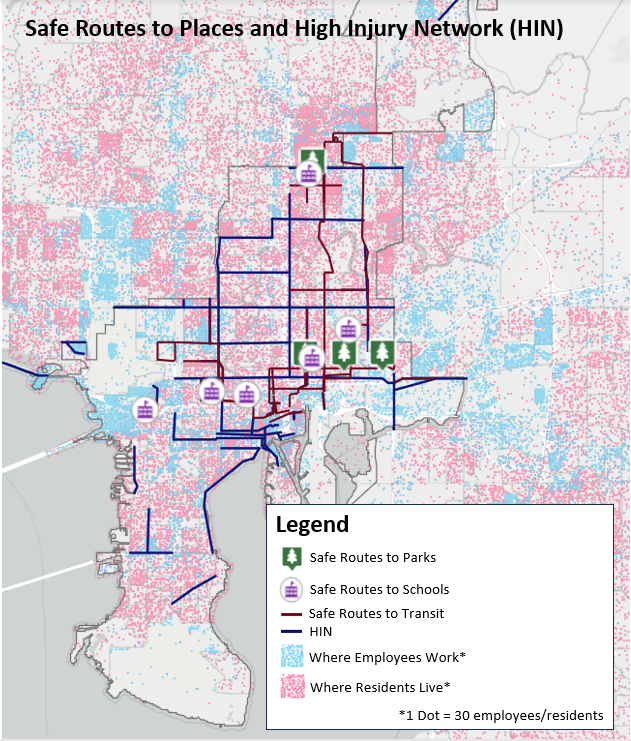
This map was produced by the Nowak Metro Finance Lab using data on where employees work from the US Census Bureau’s LEHD Origin-Destination Employment Statistics (LODES), Version 8, enumerated by census blocks. We infer the number of employees by looking at “primary job counts” per census block for those who worked in the State of Florida in 2021. Data on total residents per census block comes from the US Census 2022 5-Year American Community Survey.
Putting Plans into Action
To improve connectivity between key origins and destinations such as jobs, parks, and schools, the City of Tampa’s Vision Zero Action Plan calls for an increase in the network of multimodal facilities, including sidewalks, low stress bicycle facilities, & crosswalks across the city through an equitable prioritization process that includes ADA considerations
Community Impact
Within the Quick Build Program, Tampa has identified distinct “tracks of projects” – those that are shovel ready, those that will be design-build contract solicitations, and those that the city is in the process of designing. Once funding is disbursed, shovel ready projects within the Quick Build Program can be completed in a matter of weeks as they are authorized. The city’s approach to deploying the funding quickly will help to rapidly address the city’s road safety challenges.
“Carlos’ Story”
The City of Tampa recognizes the impact of Mayor Castor’s leadership through her Transforming Tampa’s Tomorrow (T3) initiative by highlighting residents who have seen the impact directly. One such resident is Carlos, a proud resident of North Hyde Park. Carlos enjoys riding his bike from home to downtown as a fun, affordable, and energy-efficient alternative to driving a car. Since the City of Tampa expanded the Green Spine Cycle Track along Cass Street, he feels much safer riding his bike, especially with his son.
The protected bike lanes that Carlos uses have been enabled by the Vision Zero strategy, and more will be built using SS4A funds across the city.
(From the City of Tampa, https://www.tampa.gov/transformingtampa#-infrastructure-mobility)
Conclusion
The impacts of Tampa’s Vision Zero work is already visible. In a January 2024 story from a local news outlet, Tampa’s Mobility Director, Vik Bhide, noted that the city’s numbers for pedestrian and bicyclist fatalities are trending down, and more changes will be coming to Tampa’s roads in 2024 as the city’s paving team expands their capacity with more staff and equipment. The expanded capacity will give Tampa the opportunity to fill potholes and address standard complaints about road quality, while also giving them the opportunity to redesign streets for safety. The SS4A-funded projects and overall implementation of the Vision Zero Action Plan embody the largest single investment in Tampa’s roadway safety, ever. Tampa’s ability to systematically deploy the Quick Build projects will enable them to reap the benefits of that investment expeditiously in collaboration with local and regional stakeholders. Altogether, the effort will greatly improve safety for those accessing transit, walking or biking to work, schools, or parks, and for drivers by rolling out short- and long-term interventions through a data-driven approach, focusing predominantly on underserved communities and vulnerable road users who are overrepresented in the crash data.
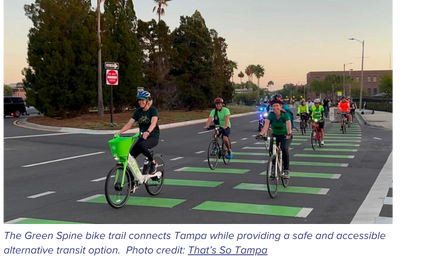
Accelerator for America would like to thank Drexel University Nowak Metro Finance Lab for their partnership in production of this case story for the Local Infrastructure Hub.



